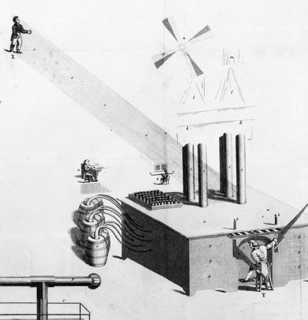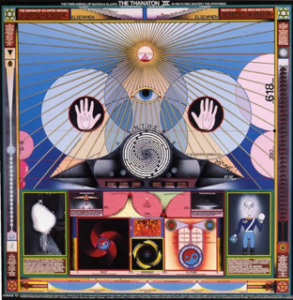A recent article in the New Yorker magazine recounted the history of an unexplained medical syndrome that has been affecting members of the American diplomatic community in Havana, Cuba. The incidents began on December 30, 2016 when a C.I.A. officer, who was operating under diplomatic cover, reported to an embassy nurse that he had experienced strange sounds while in his home, followed by painful headaches and dizziness. Over the next couple of years several other victims suffering from similar symptoms came forward. All the victims described being bombarded by waves of pressure in their heads, as if they were standing in an invisible beam of energy directed at their brains. In some cases the effects were very marked, virtually incapacitating the victims
The embassy staff were frankly baffled by all of this. Were the symptoms real or was this an example of some kind of mass hallucination? If the symptoms had a real physical basis who was responsible and how were the effects being produced? To answer the first question, 21 of the victims were analyzed by The University of Pennsylvania’s Center for Brain Injury and Repair. The investigators identified “a constellation of acute and persistent signs and symptoms in the absence of an associated history of blunt head trauma.” The investigators concluded, “In this preliminary report of a retrospective case series, persistent cognitive, vestibular, and oculomotor dysfunction, as well as sleep impairment and headaches, were observed among US government personnel in Havana, Cuba, associated with reports of directional audible and/or sensory phenomena of unclear origin. These individuals appeared to have sustained injury to widespread brain networks without an associated history of head trauma.” Indeed the symptoms seemed to be similar to injuries resulting from concussions, like those suffered by soldiers struck by roadside bombs in Iraq and Afghanistan and were described by one medical expert as “concussion without concussion”. Following the publication of these results in the Journal of the American Medical Association (JAMA), a very prestigious journal, there was a widespread discussion as to their validity and several reputable investigators took issue with the conclusions. For example, it was suggested that the victims were experiencing the effects of chronic stress due to living in a highly charged diplomatic environment. Nevertheless, the fact that the results were published by a group of highly respected and experienced clinical investigators certainly raised the strong possibility that the victims were really suffering from a mysterious “illness” produced by some type of specifically targeted intervention.
Although these incidents might seem to herald a new development in the technology of war and espionage they do have many antecedents. Indeed, as pointed out by the Viennese psychoanalyst Victor Tausk in 1919, the idea of a machine that exerts a targeted malign influence on an individual’s brain has a long history, particularly in relation to the paranoid fantasies exhibited by many patients with psychotic illnesses. One of the most striking of these occurred in the early part of the 19th century. The case concerned James Tilly Matthews, a tea broker from Wales, who, as a young man, became involved in radical politics. In the late 18th century he traveled to France to attempt to reconcile French and British interests and to prevent a war between the two countries which seemed ever more likely at the time. However, in 1793, he was arrested and incarcerated by the Jacobins who thought that he was a spy. His bizarre behavior in prison led to his release in 1796 and he returned to London. He was soon arrested for making a disturbance during a debate in Parliament and sent for treatment at St Mary of Bethlem Hospital for the Insane. Commonly known as Bedlam, the hospital was the world’s major institution at the time for the treatment of the insane. At this point he became known to John Haslam, the chief apothecary at the hospital, who was interested in his case and made copious notes describing Matthew’s symptoms over a period of several years. In 1810 Haslam published a book describing the entire case under the title “Illustrations of Madness: Exhibiting a Singular Case of Insanity, And a No Less Remarkable Difference in Medical Opinions: Developing the Nature of An Assailment, And the Manner of Working Events; with a Description of Tortures Experienced by Bomb-Bursting, Lobster-Cracking and Lengthening the Brain. Embellished with a Curious Plate”, which makes the case that Matthews was truly insane, something that Matthew’s himself vigorously denied. Matthews always contended that he had originally been sent to France to work as an agent by the British government who had then denied any involvement in the matter once he was incarcerated. Matthews also revealed that he had evidence that subversive French Jacobin agents were active in England where they were involved in political subversion and were trying to influence the minds of numerous individuals, including Matthews himself, as well as many important political figures. The manner by which these agents operated was through the operation of a machine known as the Air Loom. Matthews had considerable ability as an artist and designer (he helped to design several improvements to Bethlem hospital) and he provided meticulous drawings of the Air Loom along with precise instructions as to its mode of operation. Matthews imagined that the Air Loom was situated in the basement of a nearby house and was operated by the gang of Jacobin radicals whose goal was to ferment a continuous state of hostility between England and France. Matthews provided detailed descriptions of the various members of the Air Loom gang. According to Matthews the Jacobins were led by a malevolent and sadistic character known as ‘Bill the King’. Other members of the gang included ‘Jack the Schoolmaster’, Charlotte, ‘Sir Archy’, a foul mouthed woman in drag and the Glove Woman’,who actually operated the machine.


According to Matthews the Air Loom was able to modulate his thoughts by directing a ray of “magnetic fluid” into his brain in which the Jacobin gang had implanted a magnet. This idea was clearly in keeping with the concepts of “animal magnetism” that were popular at the time and which we will return to below. The machine drawn by Matthews looked rather like a pipe organ with barrels, pipes and dials. It was powered by a mixture of disgusting substances including ‘spermatic-animal-seminal rays’, ‘the effluvia of dogs’,”gaz from the anus of a horse” and ‘putrid human breath’. These elements were combined to produce rays of magnetic fluid which were directly fired into Matthews’ brain. The results of this were different phenomena described as ‘fluid locking’, ‘stone making’, ‘thigh talking’, ‘lobster-cracking’, ‘bomb-bursting’, and ‘brain-saying’, resulting in thoughts and actions that afflicted Matthews against his will making seem insane. Indeed, according to Matthews, the very fact that he had landed up in Bedlam clearly represented the success of operations carried out by the Air Loom gang. Matthews was convinced that the Jacobins actually operated a system of Air Looms throughout London and they had a wide influence on the brains of members of the government.
Recently a working model of the Air Loom was actually constructed for an exhibition in England, although it was not reported whether it was successfully used to influence anybody’s brain. Whether the Air Loom actually existed as Matthews had conceived it is considered to be most unlikely and he is usually thought to be one of the first carefully documented examples of a paranoid schizophrenic. Indeed, it has subsequently proved to be the case, as pointed out by Tausk in the early 20th century, that many paranoid schizophrenics believe their thoughts are being interfered with by nefarious beings of one type or another. Whatever the truth of the matter, Matthew’s drawings have great merit and occupy a prime place in the history of design of fantastical mind modulating machines, an interesting theme in the history of art.

It is clear that Matthew’s ideas were developments of the scientific issues that were being actively discussed at the time. The Scientific Enlightenment of the 17th and 18th centuries saw the rapid development of what can be considered to be identifiably modern science. A particular feature of this progress was a realization that many natural phenomena were governed by the action of invisible forces such as gravity, electricity and magnetism that acted at a distance through what appeared to be empty space. Scientists were just starting to grope their way towards an understanding of how these forces worked, precisely what phenomena they explained and how they could be manipulated. Eventually,Maxwell and others would develop the idea of a field of influence. But, to begin with, many of the theories mixed modern scientific concepts with occult ideas that had characterized previous centuries. In the late 18th century the Galvani/Volta debate had concentrated on the role of electricity in explaining how nerves influenced the movement of muscles raising the question as to the connection between electricity and the mysterious force that Vitalists imagined was responsible for sustaining life. Magnetism was also of great interest as a powerful invisible influence on living objects. One result of this interest was the work of the German doctor Franz Friedrich Anton Mesmer who developed the concept of “animal magnetism”, an invisible magnetic fluid or force that inhabited all living objects. According to Mesmer the normal flow of this force was essential to good health and many diseases might be caused by disturbances in its normal function. Starting in Vienna and then later moving to Paris, Mesmer established salons where the rich and famous could have their magnetic forces readjusted to cure them from a variety of ailments. In order to achieve these cures, Mesmer initially had patients drink iron laced liquid and then made passes over them with magnets. Later he dispensed with this kind of thing and just used his hands to make passes over his patients which he contended could readjust the flow of their animal magnetism. Mesmer’s patients were mostly women who would frequently fall into a trance and eventually perhaps begin to shake and even convulse. Apparently, once this “crisis” was over, the patient would often be cured. Many of these sessions took place in séance like surroundings in which the female patient was in close proximity to the magnetizer -perhaps even touching him, producing a strongly erotic atmosphere. The question was eventually raised as to whether in fact the cures observed really had anything to do with the magnets or other items employed or whether they were actually due to the reaction of the patient to the highly charged suggestible and erotic atmosphere. Unusually for the time, a committee was set up by the French government to investigate the matter, headed by none other than Benjamin Franklin, who certainly knew a thing or two about electricity and magnetism. The committee concluded that animal magnetism was not involved and any benefits observed were the result of autosuggestion on the part of the patient. Nevertheless, it has to be said that by proposing the role of magnetism Mesmer was striving to give his practices a rational scientific ,as opposed to a religious or occult, explanation. Indeed, although a magnetic fluid did not ultimately prove to be the basis of the effects Mesmer produced, in an important sense, animal magnetism marked the beginnings of hypnosis and techniques based on psychological suggestion. However, all that was in the future. Phenomena such as Mesmerism and its obvious spinoffs such as the Air Loom were appropriate for a time that was coming to terms with the notion that invisible lines of force pervaded the universe and could act on humans in different ways. Indeed, this wasn’t really such a new idea. In the 3rd century BC, Archimedes is said to have directed beams of concentrated sunlight onto ships besieging Syracuse in order to destroy them, a precursor to the modern science fiction idea of a “death ray”. Prior to the Scientific Enlightenment it had always been supposed that rays of influence could be directed at humans for the specific purpose of manipulating their thoughts and behaviors. In pre-scientific times these rays were thought to be divine or magical in origin. During the Renaissance magical ideas based on the influences of Hermeticism and the Kabbalah described “sympathies” and “correspondences” between objects through which lines of influence might flow. As Hermes Trismegistus, the supposed author of the writings of the Corpus Hermeticum said “As above, so below”. The earth was a microcosm that reflected the macrocosm of the heavens and was subject to rays of magical influence from above. Once the Scientific Enlightenment took hold these magical rays started to be transformed into energetic rays based on actual scientific principles underlying phenomena such as electricity and magnetism as in the case of Mesmerism. But of course the scientific knowledge of the time wasn’t sophisticated enough to provide a modern understanding of what such directed beams of energy might really achieve. So we can safely regard all of these previous ideas as examples of quaint old fashioned nonsense. Or can we……..?

When one comes to think of it, the idea that focused beams of magnetism, electricity or other “invisible” forces directed at the brain might have substantial effects on its output really isn’t that ridiculous. After all the brain is basically a complex computational device that works according to the principles of bioelectricity. Nerve cells function through shifting the distribution of charged particles (ions) across their biological membranes. Movement of these ions creates the electrical signals that allow the brain to operate. Theoretically, if we use electrical or magnetic fields to stimulate the brain we should certainly be able to alter things like the excitability of nerve cells and so the output of the brain. Indeed, over the last few years such effects have been taken increasingly seriously. Some 30 years ago a publication by Merton and Morton demonstrated that running brief electrical currents through the human scalp could be used to activate the underlying cortex and thereby affect behaviors corresponding to the activated brain areas.Since that time the use of related techniques has spread rapidly so that “Non Invasive Brain Stimulation” (NIBS) is now increasingly employed both in the experimental and clinical arenas. NIBS basically falls into two basic methodologies. transcranial magnetic stimulation (TMS), which is based on principles of electromagnetism, and transcranial electrical stimulation (tES), which harnesses small electrical currents applied to the scalp using current intensities of ~1–2 mA.
There are now a huge number of variations of these techniques but there is little doubt that they can be used to manipulate the electrical activity of the brain and the strength of synaptic transmission in ever increasingly specific ways. Indeed,such techniques may be viewed as a possible alternative to pharmacology which uses drugs to manipulate the brain through chemical intervention.The use of brain imaging techniques has confirmed the fact that specific changes in brain activity do occur under the influence of NIBS. Many of the behavioral changes observed outlast the period of stimulation to such an extent as to suggest the induction of changes involving phenomena such as long term potentiation, a cellular correlate of memory. The use of NIBS has rapidly expanded into the clinical arena and it has been suggested as being useful in treating depressive disorders, pain, aphasia, movement disorders, motor stroke, multiple sclerosis, epilepsy, disorders of consciousness, Alzheimer’s disease, tinnitus, schizophrenia, substance abuse, addiction and craving, among other things. Not only that, but NIBS techniques in their most basic forms can be relatively easy to employ resulting in a large number of DIY users. Several companies now sell equipment for DIY tES for people who just want to “improve their cognitive performance”, although there is very little hard evidence that such aims can be achieved using the equipment provided.
NIBS is produced by positioning electrodes on particular regions of the scalp and using these to elicit the required stimulation. Nevertheless, there is still a great deal of uncertainty over exactly what is actually going on in the underlying substrate of the brain. For example, transcranial direct current stimulation (tDCS) has been used to effectively modulate motor and cognitive functions in humans. tDCS protocols consist of low amplitude direct currents delivered to human brain via two electrodes placed over the scalp. Depending on electrode positioning (anode or cathode located over the target area), tDCS exerts opposite effects: “anodal” tDCS depolarizes membrane potential and increases excitability in stimulated neurons, whereas “cathodal” tDCS produces neuronal hyperpolarization and inhibits the firing of nerve cells. Having said that, precisely mapping the regions of the brain influenced and the nerve cells whose electrical properties are altered is difficult. In a broader context, electrical changes in the brain can also be produced by additional methods For example, ultrasound is a mechanical pressure wave (sound wave) having a frequency above the range of human hearing(>20 kHz). Due to its physical properties, specifically its ability to be transmitted long distances through solid structures, including bone and soft tissues, ultrasound is used in a wide range of medical and industrial applications.
Which brings us back to the victims of the mysterious Havana syndrome. One wonders if some way has been found to direct such beams of energy directly into the brains of the victims, something that could have results, not only on the electrical activity of the brain so as to produce abnormal behaviors, but also physical changes to the substrate of the brain itself. As suggested by one expert-“Most likely, the cause was a device that emitted radio frequencies or electromagnetic pulses, which entered through the victims’ ears. (Structural variations within their heads could help explain why some heard sounds while others didn’t.) Inside the head, the energy could have caused “cavitation,” or bubbling, in the tiny fluid-filled passages of the inner ear, or in arterial blood. As the bubbles formed, and in some cases exploded, they could have damaged the organs that regulate balance and orientation. If they burst inside the cranial cavity, the victim could have suffered ministrokes, causing brain damage similar to the effects of decompression sickness. “ So, the hunt goes on for a rational explanation for the symptoms afflicting the members of the Havana diplomatic community. What is more are we really sure that James Tilly Matthews was the victim of paranoid delusions? Do we really know that there wasn’t an Air Loom hidden in the depths of a nearby basement? The fact is that nobody ever took the time to look.
Further Reading:
Entous A and Anderson JL- The Mystery of the Havana Syndrome. New Yorker Magazine Nov 19th (2018)
Jay M- Illustrations of madness: James Tilly Matthews and the Air Loom (2014) Public Domain Review
Studying and modifying brain function with non-invasive brain stimulation. Polanía R, Nitsche MA, Ruff CC.Nat Neurosci. 2018 Feb;21(2):174-187. doi: 10.1038/s41593-017-0054-4. Epub 2018 Jan 8. Review. PMID:29311747
Neurological Manifestations Among US Government Personnel Reporting Directional Audible and Sensory Phenomena in Havana, Cuba. Swanson RL 2nd, Hampton S, Green-McKenzie J, Diaz-Arrastia R, Grady MS, Verma R, Biester R, Duda D, Wolf RL, Smith DH. JAMA. 2018 Mar 20;319(11):1125-1133. doi: 10.1001/jama.2018.1742. PMID: 29450484
